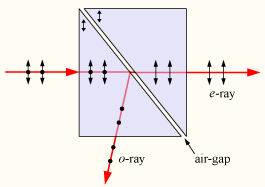.
Glan-Taylor prism

A Glan-Taylor prism reflects s-polarized light at an internal air-gap, transmitting only the p-polarized component. The optical axes are vertical in the plane of the diagram.
A Glan-Taylor prism is a type of prism which used as a polarizer or polarizing beam splitter. It is one of the most common types of modern polarizing prism.
The prism is made of two right-angled prisms of calcite (or sometimes other birefringent materials) which are separated on their long faces with an air gap. The optical axes of the calcite crystals are aligned parallel to the plane of reflection. Total internal reflection of s-polarized light at the air-gap ensures that only p-polarized light is transmitted by the device. Because the angle of incidence at the gap can be reasonably close to Brewster's angle, unwanted reflection of p polarized light is reduced, giving the Glan-Taylor prism better transmission than the Glan-Foucault design[1]. Note that while the transmitted beam is 100% polarized, the reflected beam is not.
A variant of the design exists called a Glan-laser prism. This is a Glan-Taylor prism specially made to tolerate very high beam intensities, such those produced by a laser. The differences may include using calcite which is selected for low scattering loss, improved polish quality on the faces and especially on the sides of the crystal, and better antireflection coatings. Prisms with irradiance damage thresholds greater than 1 GW/cm2 are commercially available.
YVO4 prisms based on the Glan-Taylor design have superior polarization of the reflected beam and higher damage threshold, compared with calcite Glan-Taylor prisms. These are more expensive, however, and can accept beams over a very limited range of angles of incidence.
References
1. ^ J-Y Fan et al. (2003). "A study on transmitted intensity of disturbance for air-spaced Glan-type polarizing prisms". Optics Communications 223 (1-3): 11–16.
See also
Retrieved from "http://en.wikipedia.org/"
All text is available under the terms of the GNU Free Documentation License

